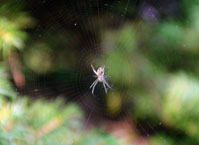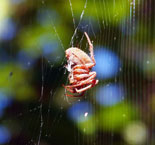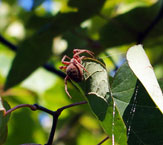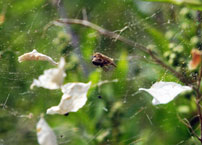home | fall garden | deciduous & conifer garden
Spider
Spiders are the largest order of arachnids and rank 7th in total species of diversity among all other group of organisms. There are more than 37,000 species with thousands of species still unrecorded. Spiders are found world-wide on every continent except for Antarctica and have established themselves in nearly every habitat. Spiders range in size and color, but they all have eight legs and fangs that inject venom. Their abdomens bear appendages called spinnerets that extrude silk from up to six types of silk glands within their abdomen. This silk is used to spin a web that is very elastic and can stretch before breaking and losing its shape. Webs vary in size, shape, and amount of sticky thread used. Spiders use their web to catch prey. A plant-eating species was found in 2008, but all other known species are predators mostly preying on insects and other spiders. Spiders' guts are too narrow to take on solids, so they liquidize their food by injecting digestive enzymes into the prey. A female spider will lay up to 3,000 eggs in one or more silk egg sacs. In some species, the female dies after egg laying, but females of some species protect the sacs by attaching them to their web, hiding them in nests, or by attaching them to their spinnerets with which they drag the eggs behind them. Baby spiders go through all their larval stages inside the egg and hatch as spiderlings. Some spiders care for their young, for example a wolf spider brood cling to the rough bristles on their mother's back. Below are just a few examples of the spiders we found living out in the garden.
 |
 |
 |
 |
 |
